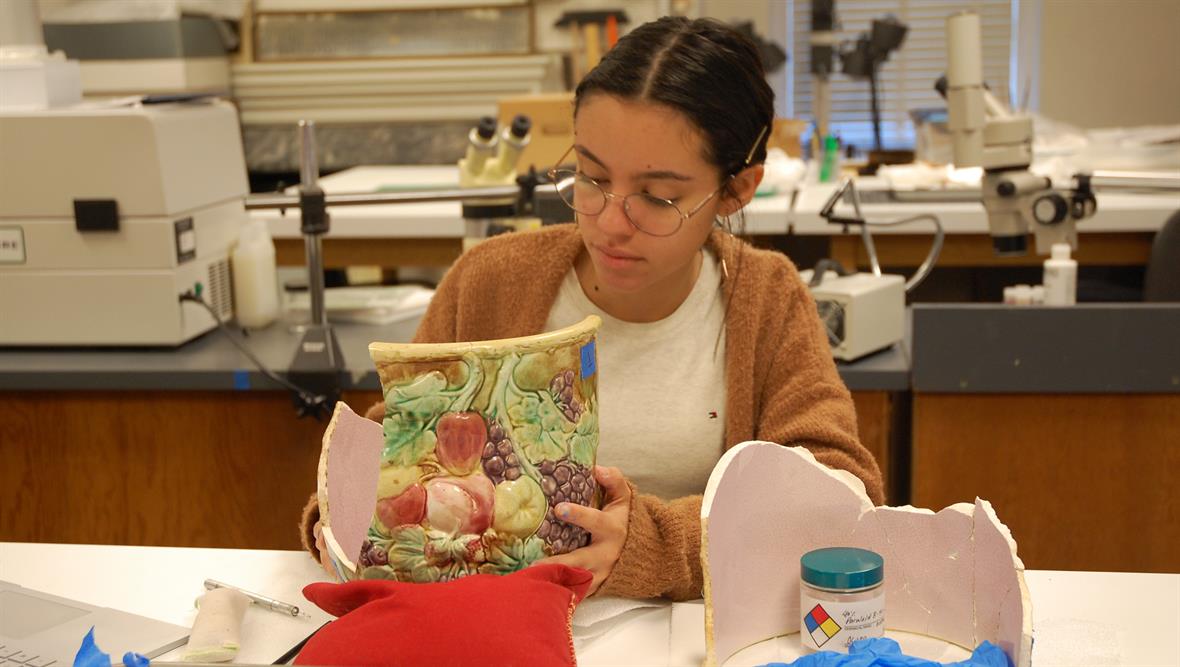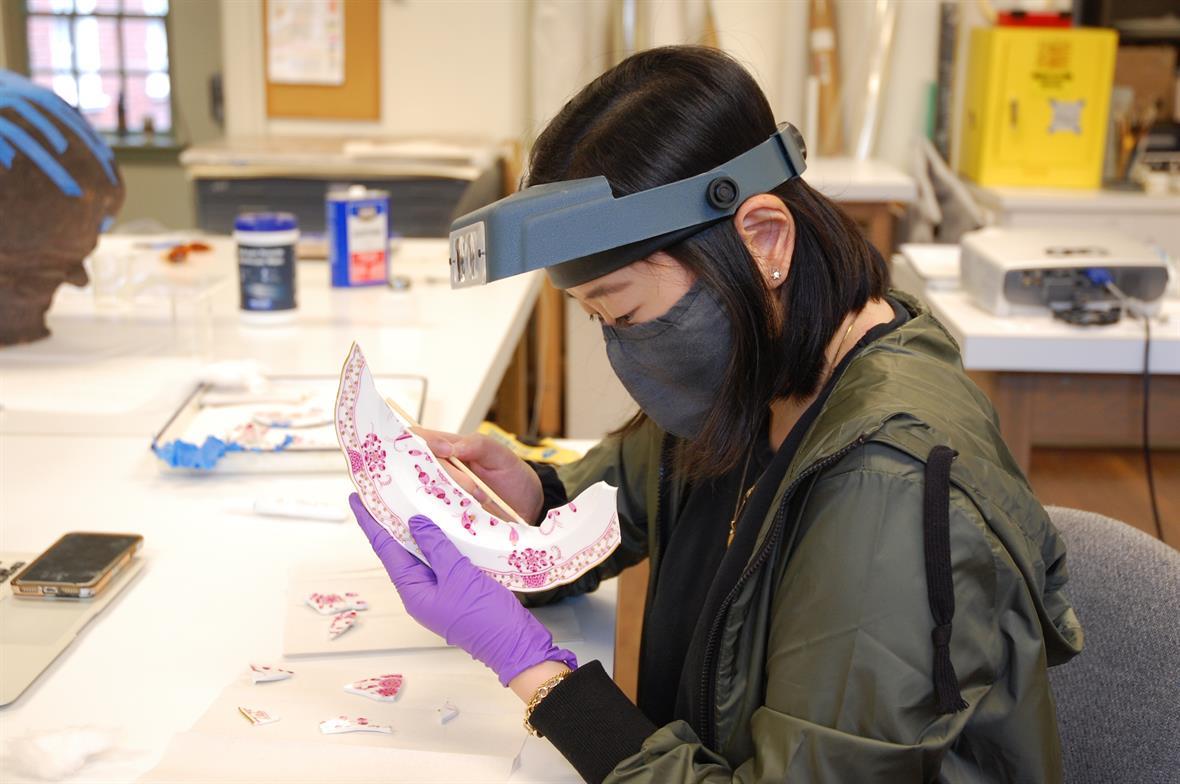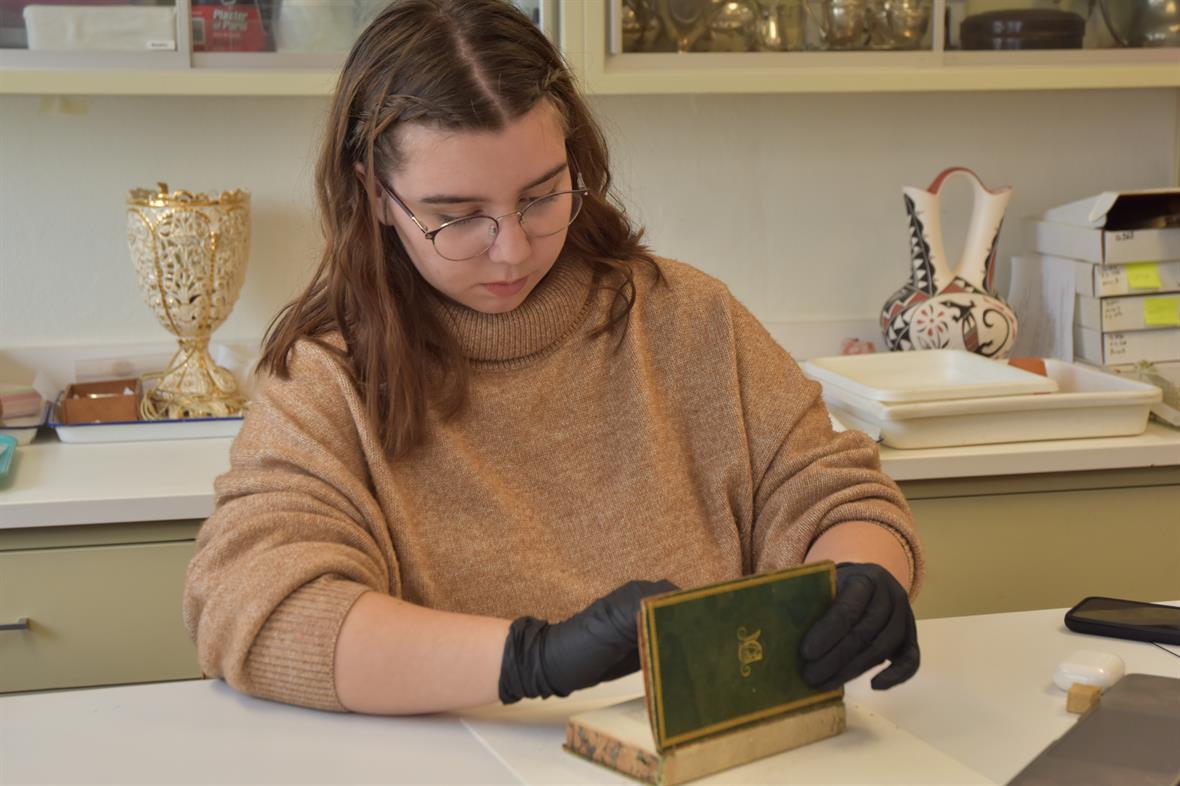
Undergraduate Programs
the Art Conservation Major
Our Value Statement reflects our commitment to educating professionals skilled in the analysis, treatment, and preservation of cultural artifacts by connecting disciplines in the arts, humanities, and sciences.
The University of Delaware's Art Conservation department offers the only undergraduate degree in art conservation taught solely by professional conservators. Our degree helps prepare students for museum careers and graduate-level study in the conservation of material culture, historic preservation, museum studies, library science, and other allied fields. Material culture includes all objects made or modified by humans—from photographs and archival documents, to decorative and fine art objects like paintings, from clothing and domestic possessions to archaeological and natural history specimens and more!
Considering the Art Conservation Field?
It may seem daunting to look at post-graduation plans at the beginning of your undergraduate career, but it is essential to prepare for highly competitive graduate art conservation programs, if that is the path you choose. An undergraduate degree in art conservation gives you the qualifications to work as a conservation technician or in a collections care position. However, a graduate degree is necessary to become a practicing conservator. There are programs all over the world, but only five in the United States.
Interdisciplinarity is an advantage!
There are many options for graduates of the undergraduate art conservation program beyond art conservation grad school. 45-50% of our graduates choose to pursue graduate studies in art conservation while 25% are in related fields such as museum collection management, museum education, historic preservation, or library sciences. The remaining 30% use the interdisciplinary skills gained from an art conservation major to pursue careers outside of museums: law, software development, business, or teaching.The undergraduate major in art conservation began in 1971 as an interdepartmental degree based in art history and chemistry. Today, the undergraduate degree in art conservation has around 75 undergraduate majors in all four years of study. Our undergraduate degree is truly interdisciplinary and makes the most of a liberal arts education!
Frequently Asked Questions
Because US conservation graduate programs have prerequisites, be sure that the undergraduate program you select provides all of these. For example, entry into the Winterthur/University of Delaware Program in Art Conservation currently requires:
- A BA, BFA, or BS (or the international equivalent) with a GPA of at least 2.5 and 3.0 in you major concentration
- At least 18 semester credits (6 courses) in material culture-related studies: anthropology, archaeology, art history, history, museum studies, or library and information studies
- At least 16 credits (4 courses) in science, general chemistry I and II with lab, organic chemistry with lab, and an additional science course, for example: biochemistry, biology, biological anthropology, inorganic chemistry, material science, mineralogy, organic chemistry II, or physics
- At least 12 semester credits (4 courses) in art or the equivalent from studio courses taught at museums or community centers, including: architectural drawing, bookbinding, ceramics, drawing, graphic design/CAD, metalsmithing, painting, photography, printmaking, sculpture, textile/fashion/fiber arts, videography, or woodworking
- At least 400 hours of conservation experience with collections professionals
The UD undergraduate curriculum provides all these courses and more!
UD offers several in-house conservation treatment courses each semester. Additionally, students receive help finding external internships. UD's winter session affords a great opportunity to study abroad or hold an outside internship. Our students have interned in many institutions across the United States and around the world, including at Winterthur Museum, with Roberto Nardi (Centro di Conservazione Archeologica) on Roman mosaics in Italy, and with Dr. Caitlin O'Grady (University College London) at Kaymakçı Archaeological Project, an archaeological site in Turkey, to name a few.
The undergraduate art conservation degree alone does not qualify someone to be an art conservator. The terminal degree in the art conservation profession is a master's. After graduation, the majority of students either go directly to graduate school or pursue internships to prepare for graduate studies.
There are 4 full-time conservation faculty members on-site at the University of Delaware. Additionally,14 affiliated art conservation faculty members, associated primarily with the graduate program, often provide internships and courses for undergraduate students. Professional conservators are your most important mentors to prepare you for the competitive nature of art conservation graduate programs. They help you connect the dots between art, material culture, and science. Professional conservation faculty are here to help you network within the field and provide hands-on learning experiences. Undergraduates at UD have an average of 6 courses with professional conservators throughout the course of their studies. Our program is unique in providing this level of mentoring and personalized learning.
Conservation is by nature an interdisciplinary field. At UD we encourage art conservation students to pursue minors or double majors, often in art history, anthropology, or chemistry, and select from a variety of minors too. This provides students breadth, giving them the opportunity to explore related interests while combining technical conservation with soft skills, maximizing the time they spend at UD.
Examples of minors commonly chosen by art conservation undergraduates include:
Africana studies, anthropology, art history, Asian studies, chemistry, fashion history, fine art, global studies, history, the Horn Program in Entrepreneurship, interactive media, Islamic studies, languages, Latin American studies, material culture studies, materials science, museum studies, public policy, and wildlife conservation.
Art Conservation training takes a village! At UD we have the most well-developed village—after all we have been training pre-program art conservation students since 1971!
The UD undergraduate program is fully run and taught by art conservators. Our faculty represent a range of specialties within the field: objects, paintings, photography, preventive, and conservation science. Our conservation courses will ground you in the principles of preventive conservation and foster the ethical understanding and hand skills necessary to become a successful professional conservator.
About 45-50% of our students go on to pursue careers and graduate training in the museum field. Because the major is so interdisciplinary, it can be applied to many different other careers. Some students discover that they are better suited towards or interested in becoming archivists, librarians, art historians, historians, anthropologists, conservation scientists, registrars, collections managers, researchers, historic preservationists, etc.
Some students are more suited to chemistry than others—it really depends on the student. Interestingly, sometimes art students actually do better in organic chemistry than in general chemistry because of the spatial relationships that are studied. Organic chemistry is challenging and requires your full attention and effort. The University and the Art Conservation Club have study groups and a variety of tutoring resources on campus.







